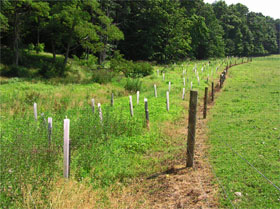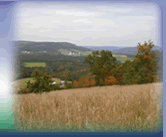CONSERVATION PRACTICE 22 ~
FORESTED STREAM RIPARIAN BUFFERS
Printable PDF File of Conservation Practice 22 (CP 22)
(Brochure will open in new window)
| Description: |
Guidelines: |
| CP 22, forested stream riparian buffer, is designed to re-establish a forested riparian buffer along stream corridors. If needed, streambank fencing to exclude livestock, watering systems, and native tree, shrub, and grass plantings are provided with this conservation practice. |
Buffer must be a minimum width of 35 feet and a maximum average width of 180 feet. A grass buffer of more than 20 feet cannot be exceeded without having a forested buffer of 100 feet. To get cost-share assistance from the state of Pennsylvania, buffers must be a minimum width of 50 feet. |
 What is a Forested Stream Riparian Buffer? What is a Forested Stream Riparian Buffer?
Strips of trees and/or shrubs along the edges of streams and waterways that filter runoff and stabilize banks. A forested stream riparian buffer is ideal as an effective filter system. In addition, trees and co-existing vegetation aid in flood control by slowing the velocity at which water travels through a watershed.
|
| Eligibility: |
Conservation Practice Responsibilities: |
Most non-forested cropland, hayland, or marginal pastureland (as determined by USDA) within 180 feet of a stream can be enrolled in CP 22. Landowners need not be farmers; however, CREP participants must have owned or operated the designated land for a minimum of one year to meet enrollment approval.
|
Land enrolled in CP 22 cannot be mowed outside the designated mowing season. Invasive plant species must be controlled within enrolled land through spot spraying. Practice upkeep is the responsibility of the contract holder, including fence repair.
Tips for successful buffers |
| Conservation Benefits: |
Additional Benefits: |
- Protection of permanent and seasonal streams
- Reduced nutrient, sediment, and pesticide contamination of streams and other waterways.
- Regulate water temperature through tree shading.
- Restoration of natural streambed conditions.
|
- Stabilized livestock crossings and watering systems
- Reduction in soil loss from streambank erosion.
- Financial savings and income on marginal agricultural land.
- Livestock health improvements from reduced exposure to waterborne bacteria, lower somatic cell counts and improved weight gain
|
Possible Wildlife Attracted to CP 22 Forested Stream Riparian Buffers
For the wildlife enthusiast, the habitat established by CP 22 is utilized by a variety of animal and insect species throughout the seasons. Mammals and birds will use the riparian areas for feeding, cover, and nesting purposes. Many desirable insects will use the areas as a hub for activities during the warmer months. Landowners who have established CP 22 on their property can look forward to the increase of wildlife seen in the area!
$$$$$$$$$$$ Funding, Reimbursements, and Rental Payments $$$$$$$$$$
By installing a forested stream riparian buffer through CREP you will receive 50% reimbursement for practice establishment (cost share), annual rental and maintenance payments, and incentive payments from the USDA Farm Service Agency (USDA FSA). If the buffer is at least 50 feet wide you will receive 50% cost-share from the Pennsylvania Department of Environmental Protection (DEP) through the Pennsylvania Association of Conservation Districts (PACD).
- Rental Payment: Calculated by multiplying the Average Base Soil Rental Rate x 250%.
- Cost Share: (for PA DEP cost share buffer must be a minimum of 50 feet wide)
- 50% from USDA FSA
- 50% ($1250 per acre maximum with fence; $850 per acre maximum without fence) from DEP
- Practice Incentive Payment (PIP): 40% of eligible practice installation costs
- Signup Incentive Payment (SIP): $10 per acre x number of contract years (10 or 15 year enrollment option).
- Annual Maintenance Payments: $7 to $10 per acre per year
A landowner enrolling in CP 22 is responsible for the up front costs of installing the practice and contacting a contractor to install a stream buffer, so be sure and tell your contractor that they are installing a CREP buffer.
Technical Assistance Available for CREP CP 22 Forested Stream Riparian Buffers
What to do first: Call your local USDA Farm Service Agency or Natural Resources Conservation Service office. Tell them you are interested in installing a forested buffer on your land through CREP, then ask them for more information about the benefits of buffers on your farm!
Click here for more information on buffers in the Original CREP region.
Click here for more information on buffers in the Expansion CREP region.
Page updated on:
July 10, 2006
|



